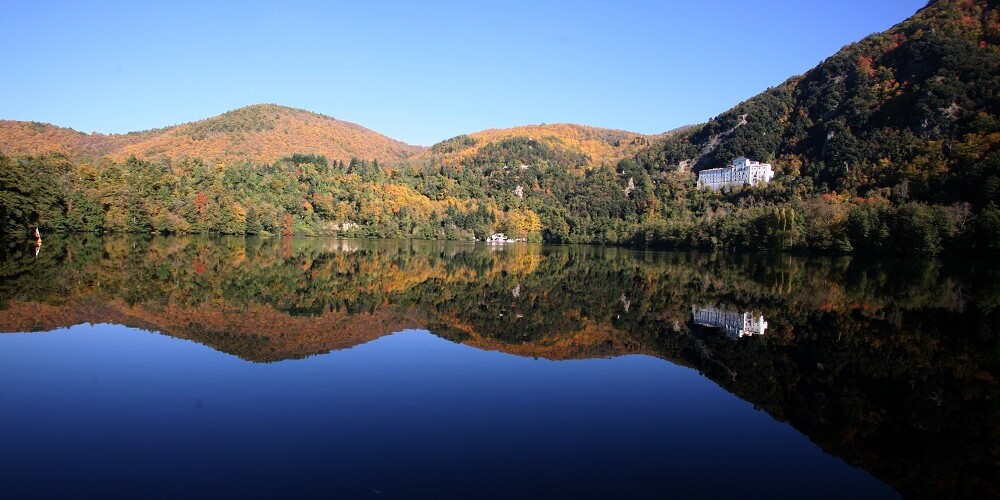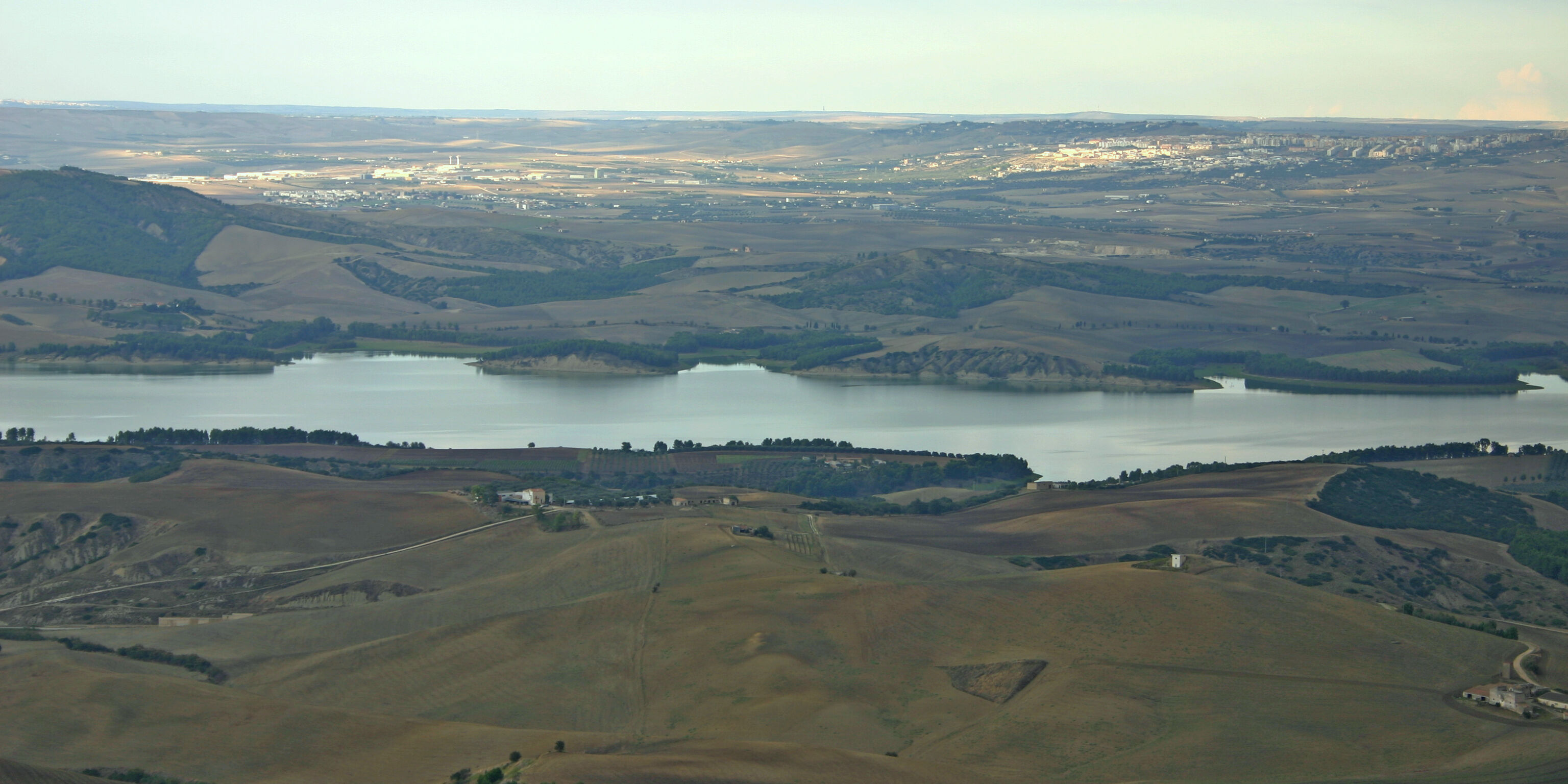Located in Policoro, the nature reserve is perfect for families. Within the reserve, it is possible to visit the Recovery Centre for Wild Animals (CRAS) and participate in various activities organised by the Environmental Education Centre (CEA), which include forest walks, horse riding on the beach, archery and water sports such as canoeing and sailing.
Located in the area of Vulture within some enchanting scenery, and surrounded by lush vegetation, are the two Monticchio lakes, of different size, and a Regional Reserve.
The lakes originated inside the carter of the Vulture mount, a now extinct volcano; beautifully reflected in the waters of the lake there is the splendid Benedictine Abbey of San Michele. Built on the ancient crater sides, the abbey and the remains of St. Ippolito complex bear witness to the presence of monks orders in the area of Vulture. The abbey boasts some beautiful frescoes dating back to the mid-eleventh century.
The Abbey of San Michele hosts the Museum of Natural History of the Vulture, which is divided into seven sections (the journey of the ancient men of Vulture; the fauna path; the flora path; the ‘Gea’ path; laboratories and temporary exhibitions; habitats and collections; the cradle of the rare ‘Bramea’ moth) that explore the history of the Homo Erectus of Atella, from ancient to present times, also offering insights on the urban settlements of the area and natural and animal life.
Trekking and horse riding lovers, but also cycling enthusiasts, are sure to find everything they are looking for in this natural paradise covered in woods, green slopes, immense plateaus and nature tracks that lead to fairytale landscapes.
Established in 2011, Montalbano Ionico Reserve – the largest of Basilicata – boasts unique geological features and is rich in outstanding natural, environmental, archaeological and cultural heritage.
The typical gullies and ravines known as ‘Calanchi’ extend up to the cultivated fields, surrounded by Mediterranean vegetation, pines and cypresses that exhibit unique and absolute landscapes, such as the geosite of Tempa Petrolla, a rocky outcrop emerging from the clay.
The landscape of Calanchi is rich in flora and fauna, especially birds. For this reason, the Reserve has been identified at the European level as an I.B.A. (Important Bird Area).
The reserve offers plenty of nature tracks, such as the ‘Gardens’: mule tracks that have been used, since the ancient times, to connect the old village to the area of Val d’Agri, stretching from the Ionian Sea to the peaks of the Pollino National Park. Many of these tracks cross the most important geological sites of the regional reserve of Calanchi in Montalbano Ionico, and today they have become ideal routes for exciting excursions and walks.
Visit this protected area, rich in charming natural attractions and fossils found on the shores of the lake, and step into a fairytale.
The history of the Regional Reserve of San Giuliano is linked to the origins of San Giuliano artificial lake, which includes the natural lake of San Giuliano, surrounded by woods and rivers both upstream and downstream of the artificial lake.
In August 2006, a skeleton fossil of whale, dating back to the Pleistocene, was found on the shores of the lake. The reserve has a visitor’s centre, a Natural Museum and an outdoor teaching space, ideal for the most little ones.
Here you can practice climbing, archery and bird-watching, and also enjoy different trekking and walking routes.
The beautiful regional reserve of ‘Abetina’ is one of Basilicata’s protected areas and falls within the municipality of Laurenzana, at the heart of the National Park of Appennino Lucano ‘Val d’Agri Lagonegrese’.
Covering 330 hectares, the reserve boasts hugely diverse flora, with the predominance of the rare white fir, along with beech and oak.
Fauna is also extremely varied and includes the wolf, the wild cat, the hare, the dormouse and the garden dormouse. Among birds, it is worth mentioning the red kite, the sparrowhawk, the linsang and the kestrel.
The reserve is opened all year round and organises guided tours also for schools coming from Basilicata and other regions.
Located just a few kilometres from the regional capital and serving as a meeting place for nature lovers, in the municipality of Pignola lies the outstanding regional nature reserve and WWF Oasis of Pantano lake.
This protected area is very popular, all year round, among jogging and walking enthusiasts, and it also hosts marathons and sports competitions of national and international level.
Offering nature tracks provided with piers and sighting spots, it is the ideal location for bird-watching enthusiasts and for those looking for mountain bike routes. There is also an area to practice archery.
In the surroundings, you will find stables, karting circuits and small aircraft available for visitors. Schools often organise excursions to take students to the didactic garden and the play area especially designed for children.
The reserve also hosts a centre for environmental education and a recovery centre for wild animals.
The Observatory is located in the Pollino National Park, in Senise, on a promontory of Lake Monte Cotugno, the largest artificial lake on clay in Europe and third in the world.
Thanks to the variety of environments you can admire many different species of sedentary and migratory birds, both aquatic and terrestrial: Red kites, Buzzards, Falcons, Grey wagtails, Shelducks, Crested grebes, Egrets, Sandpipers, Mallards, Coots, Hoopoes, Moorhens, Cormorants, Herons, Wigeons, Stone-curlew, Wheatears, Lanners.
Mediterranean brush dominates the shores of the Lake with specimens of mastics, green olive trees, juniper, rock roses, common bladder senna, intertwined with oak forests which alternate with thick forests of pines and colourful hills with flowers of every variety.
ACTIVITIES
This place of enchanting landscapes fascinates visitors with its wild, untouched nature; it’s ideal for those who are interested in ornithology, bird-watching and photography. The environments are very diverse: there are green fields where you can go horse-riding or take a walk, or go trekking or climbing for the more experienced; also desert hills where you can enjoy cross mountain biking.
EDUCATIONAL WORKSHOPS
There are countless activities and workshops offered for guided tours to groups and schools of all levels, degrees and fields of study: environmental education for example, as well as morphological evolution, orienteering, mimicry, recycling, art and nature, restoration of agricultural traditions, etc.



































